三年级上册英语 全册教案 外研社(三起)
外研(三起)三年级英语上册全册教案

外研版(三起)三年级英语上册全册教案Module 1功能:问候和道别/自我介绍语言:Hello. Hi. I’m…. Goodbye. Bye-bye. Good morning.How are you?I’m fine,thank you.词汇:helIo (hi),I am (I’m),goodbye(bye-bye),Good morning,How are you?Fine, thank you,and you?Unit 1 I’m Sam准备导入:1.教师在走进教室时热情地向同学们打招呼说:Hello或Hi.与近处的同学握手,向远处的同学挥手。
表扬那些用英语向师打招呼的同学说:Very good!Well done!或Clever boy/girl!2.用英语告诉学生本人名字,说:I’m Mr Guo.并将名字写在黑板上。
活动1:听音指图1.打开并举起书,让学生看到练习。
指着各幅图用中文问学生图中的情景(校园中Sam,Daming,Amy和Lingling在介绍他们自己;在离开学校时,他们互相道别)。
问他们认为图片上的孩子来自哪里?他们是高兴还是不高兴?每幅图上的孩子在说什么?2.放录音或读对话。
学生看书听录音。
放录音时教师要举起书指着图上说相应话语的人物。
再放录音,要求学生们指着相应的说话的人物。
活动2:听音说话1. 读出前两幅图的对话,要求学生跟读。
2.向学生解释老师将以故事中不同人物的身份来介绍自己。
每次老师说:Hello,I’m(人物的姓名),他们要回答:Hello,(同一人物的姓名)。
举例:老师:Hello,I’m Lingling.学生:Hello,Lingling.3.用Sam和Amy做更多的例子。
每个名字练习多次。
4.告诉学生老师要点名让一些学生做自我介绍。
老师在黑板上写出句型结构。
老师:指向一个学生学生:Hello,I’m Mr Guo。
全班:Hello,Mr Guo。
三年级上册外研版英语教案5篇
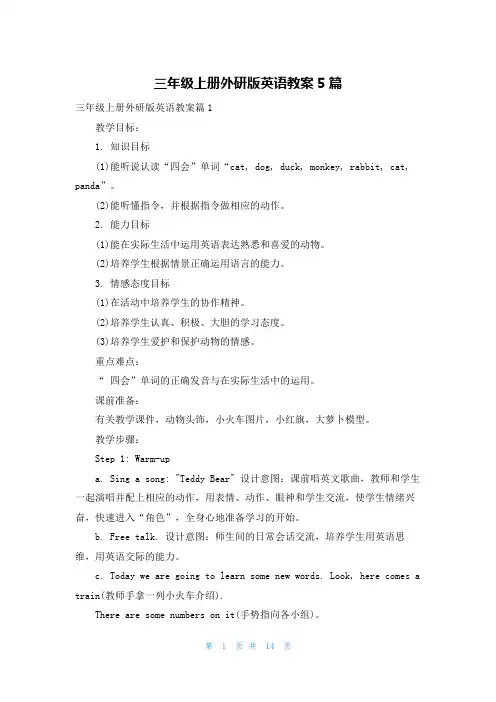
三年级上册外研版英语教案5篇三年级上册外研版英语教案篇1教学目标:1. 知识目标(1)能听说认读“四会”单词“cat, dog, duck, monkey, rabbit, cat, panda”。
(2)能听懂指令,并根据指令做相应的动作。
2. 能力目标(1)能在实际生活中运用英语表达熟悉和喜爱的动物。
(2)培养学生根据情景正确运用语言的能力。
3. 情感态度目标(1)在活动中培养学生的协作精神。
(2)培养学生认真、积极、大胆的学习态度。
(3)培养学生爱护和保护动物的情感。
重点难点:“ 四会”单词的正确发音与在实际生活中的运用。
课前准备:有关教学课件,动物头饰,小火车图片,小红旗,大萝卜模型。
教学步骤:Step 1: Warm-upa. Sing a song: "Teddy Bear" 设计意图:课前唱英文歌曲,教师和学生一起演唱并配上相应的动作,用表情、动作、眼神和学生交流,使学生情绪兴奋,快速进入“角色”,全身心地准备学习的开始。
b. Free talk. 设计意图:师生间的日常会话交流,培养学生用英语思维,用英语交际的能力。
c. Today we are going to learn some new words. Look, here comes a train(教师手拿一列小火车介绍).There are some numbers on it(手势指向各小组)。
Number 1 is for group 1; Number 2 is for group 2; Number 3 is for group 3; Number 4 is for group4.(教师拿出一面小红旗)If you do very well, you can get a red flag for your group. Let's see which group is the best. OK?(教师以手势鼓动学生回答:OK.)设计意图:小学生好胜心强,从开始就把竞争机制引入课堂,并贯穿于整堂课,大大激发了学生的学习兴趣,有利于学生完全投入到课堂活动中来。
外研社小学三年级英语上册完整教案(三年级起点)
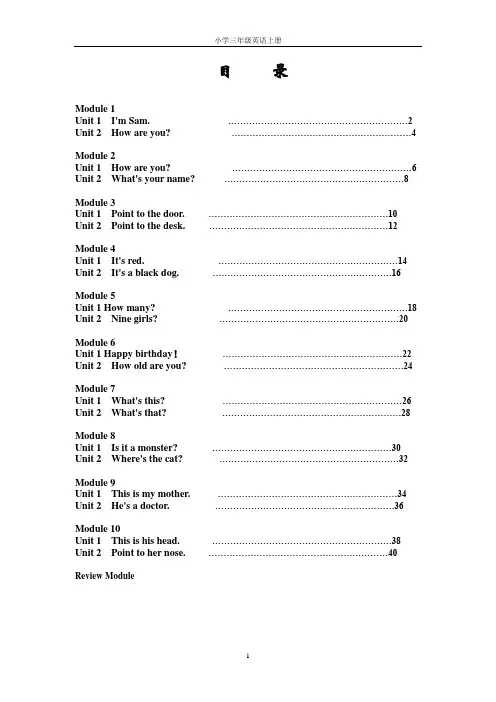
目录Module 1Unit 1 I'm Sam. (2)Unit 2 How are you? (4)Module 2Unit 1 How are you? (6)Unit 2 What's your name? (8)Module 3Unit 1 Point to the door. (10)Unit 2 Point to the desk. (12)Module 4Unit 1 It's red. (14)Unit 2 It's a black dog. (16)Module 5Unit 1 How many? (18)Unit 2 Nine girls? (20)Module 6Unit 1 Happy birthday! (22)Unit 2 How old are you? (24)Module 7Unit 1 What's this? (26)Unit 2 What's that? (28)Module 8Unit 1 Is it a monster? (30)Unit 2 Where's the cat? (32)Module 9Unit 1 This is my mother (34)Unit 2 He's a doctor (36)Module 10Unit 1 This is his head. (38)Unit 2 Point to her nose (40)Review Module一、【教学目标与策略方法】(一)知识与技能1、能听懂、会说、会读新单词old、how old、look、too及新句型How old are you ? I’m … . I’m… too.(重点)2、能运用How old are you ? I’m … . I’m… too.进行简单的交流。
(难点)(二)教学方法情景教学法【教学过程】一、导学1、师生问候T:Good morning, boys and girls.S:Good morning, Miss Huang.T:How are you? S:I’m fine, thank you. And you?T:I’m fine, too, Thank you.2、带领学生唱学过的英文歌:Ten little fingers. 对学生的表现进行鼓励表扬。
外研社三年级上册英语教案(精选3篇)
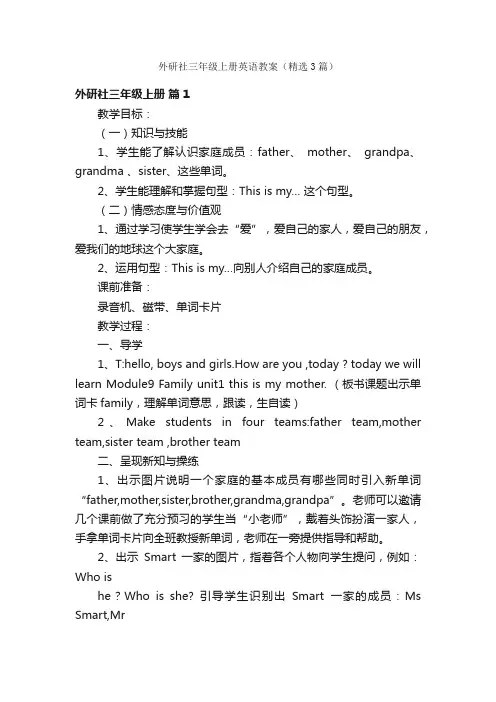
外研社三年级上册英语教案(精选3篇)外研社三年级上册篇1教学目标:(一)知识与技能1、学生能了解认识家庭成员:father、mother、grandpa、grandma 、sister、这些单词。
2、学生能理解和掌握句型:This is my… 这个句型。
(二)情感态度与价值观1、通过学习使学生学会去“爱”,爱自己的家人,爱自己的朋友,爱我们的地球这个大家庭。
2、运用句型:This is my…向别人介绍自己的家庭成员。
课前准备:录音机、磁带、单词卡片教学过程:一、导学1、T:hello, boys and girls.How are you ,today ? today we will learn Module9 Family unit1 this is my mother. (板书课题出示单词卡family,理解单词意思,跟读,生自读)2、Make students in four teams:father team,mother team,sister team ,brother team二、呈现新知与操练1、出示图片说明一个家庭的基本成员有哪些同时引入新单词“father,mother,sister,brother,grandma,grandpa”。
老师可以邀请几个课前做了充分预习的学生当“小老师”,戴着头饰扮演一家人,手拿单词卡片向全班教授新单词,老师在一旁提供指导和帮助。
2、出示Smart一家的图片,指着各个人物向学生提问,例如:Who ishe?Who is she? 引导学生识别出Smart一家的成员:Ms Smart,MrSmart,Sam,Amy和Tom.对学生说:“Sam家里还有两个成员,大家知道他们是谁吗?刚才大家看到的这些任务之间又是什么关系呢?我们一起来看一看吧!”三、自学与展示1、播放录音请学生认真听,试着理解课文的内容。
听过第一遍录音后,老师可以提出一些关于课文的具体问题,例如:“How many people are there in sam `s family?”请学生带着问题听第二遍录音后,老师可以请理解课文内容的学生内容的学生向其他同学提出问题,例如:“Who are they?”听第3遍录音时,请学生看着书跟读,画出生词,并试着找出问题的答案。
外研版小学三年级英语上册教案全册
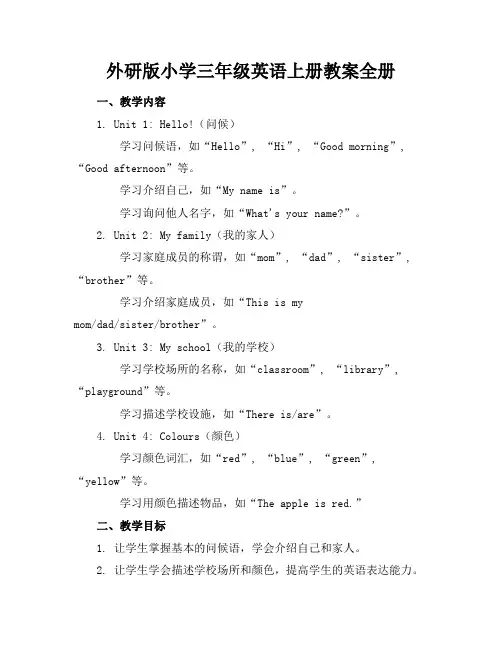
外研版小学三年级英语上册教案全册一、教学内容1. Unit 1: Hello!(问候)学习问候语,如“Hello”, “Hi”, “Good morning”, “Good afternoon”等。
学习介绍自己,如“My name is”。
学习询问他人名字,如“What's your name?”。
2. Unit 2: My family(我的家人)学习家庭成员的称谓,如“mom”, “dad”, “sister”, “brother”等。
学习介绍家庭成员,如“This is mymom/dad/sister/brother”。
3. Unit 3: My school(我的学校)学习学校场所的名称,如“classroom”, “library”, “playground”等。
学习描述学校设施,如“There is/are”。
4. Unit 4: Colours(颜色)学习颜色词汇,如“red”, “blue”, “green”, “yellow”等。
学习用颜色描述物品,如“The apple is red.”二、教学目标1. 让学生掌握基本的问候语,学会介绍自己和家人。
2. 让学生学会描述学校场所和颜色,提高学生的英语表达能力。
三、教学难点与重点1. 教学难点:家庭成员和颜色的词汇掌握,句子结构的应用。
2. 教学重点:问候语的使用,介绍自己和家人,描述学校场所和颜色。
四、教具与学具准备1. 教具:PPT,图片,卡片,彩色粉笔。
2. 学具:课本,练习册,彩色笔。
五、教学过程1. 导入:通过唱英文歌《Hello Song》进行热身,引导学生相互问候。
2. 新课呈现:呈现PPT,展示教材中的图片,引导学生学习新词汇和句子。
3. 例题讲解:讲解问候语和介绍自己的例题,引导学生模仿和练习。
4. 随堂练习:让学生分组练习介绍家人,描述学校场所和颜色。
六、板书设计1. 小学三年级英语上册教案2. 内容:Unit 1: Hello!问候语:Hello, Hi, Good morning, Good afternoon自我介绍:My name is询问名字:What's your name?Unit 2: My family家庭成员:mom, dad, sister, brother介绍家人:This is my mom/dad/sister/brother Unit 3: My school学校场所:classroom, library, playground描述学校:There is/areUnit 4: Colours颜色:red, blue, green, yellow描述颜色:The apple is red.七、作业设计1. 作业题目:根据所学内容,编写一段自我介绍,包括问候语、姓名、年龄和家庭成员。
三年级英语上册 整册教案-外研社(三起)
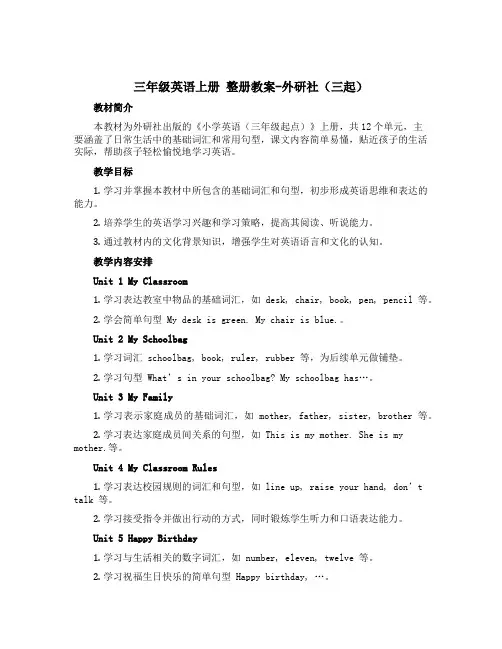
三年级英语上册整册教案-外研社(三起)教材简介本教材为外研社出版的《小学英语(三年级起点)》上册,共12个单元,主要涵盖了日常生活中的基础词汇和常用句型,课文内容简单易懂,贴近孩子的生活实际,帮助孩子轻松愉悦地学习英语。
教学目标1.学习并掌握本教材中所包含的基础词汇和句型,初步形成英语思维和表达的能力。
2.培养学生的英语学习兴趣和学习策略,提高其阅读、听说能力。
3.通过教材内的文化背景知识,增强学生对英语语言和文化的认知。
教学内容安排Unit 1 My Classroom1.学习表达教室中物品的基础词汇,如 desk, chair, book, pen, pencil 等。
2.学会简单句型 My desk is green. My chair is blue.。
Unit 2 My Schoolbag1.学习词汇 schoolbag, book, ruler, rubber 等,为后续单元做铺垫。
2.学习句型What’s in your schoolbag? My schoolbag has…。
Unit 3 My Family1.学习表示家庭成员的基础词汇,如 mother, father, sister, brother 等。
2.学习表达家庭成员间关系的句型,如 This is my mother. She is my mother.等。
Unit 4 My Classroom Rules1.学习表达校园规则的词汇和句型,如line up, raise your hand, don’t talk 等。
2.学习接受指令并做出行动的方式,同时锻炼学生听力和口语表达能力。
Unit 5 Happy Birthday1.学习与生活相关的数字词汇,如 number, eleven, twelve 等。
2.学习祝福生日快乐的简单句型Happy birthday, …。
Unit 6 My Toys1.学习表示玩具种类的词汇,如 doll, car, train, ball 等。
外研版3起三年级英语上全册教案教学设计
外研版3起三年级英语上全册教案教学设计一、教学内容本节课选自外研版3起三年级英语上册,涉及单元《At the Zoo》。
教学内容包括:Unit 1《What's this? It's a 》,Unit 2《I can see 》以及《Rhyme Time》。
详细内容涵盖动物名词、一般疑问句、肯定回答、描述性句型以及韵律歌谣。
二、教学目标1. 学生能够听懂、会说、认读动物名词如:panda, elephant, lion, tiger等。
2. 学生能够使用一般疑问句“What's this?”和肯定回答“It'sa ”来询问和描述动物。
3. 学生能够使用描述性句型“I can see ”来描述所看到的动物。
三、教学难点与重点1. 教学难点:动物名词的拼写和发音,一般疑问句和描述性句型的运用。
2. 教学重点:动物名词的认读,一般疑问句和描述性句型的实际运用。
四、教具与学具准备1. 教具:PPT,动物卡片,教学录音机。
2. 学具:学生用书,练习册,动物名词卡片。
五、教学过程1. 导入:通过展示动物园的图片,引出话题,引导学生谈论他们在动物园看到的动物。
2. 呈现:呈现Unit 1和Unit 2的单词和句型,结合PPT展示,让学生跟随录音学习。
3. 实践:学生两人一组,用所学句型进行问答练习,描述动物。
4. 例题讲解:以panda为例,讲解一般疑问句“What's this?”和肯定回答“It's a ”的使用。
5. 随堂练习:学生根据PPT上展示的动物图片,使用所学句型进行描述。
7. Rhyme Time:学生跟随录音,学习韵律歌谣,巩固所学内容。
六、板书设计1. 动物名词:panda, elephant, lion, tiger等。
2. 句型:What's this?It's aI can see七、作业设计1. 作业题目:a. 根据图片,写出对应的动物名词。
外研版小学三年级英语上册教案全册
外研版小学三年级英语上册教案全册一、教学内容1. Unit 1 Hello!(第13页)学习问候语,介绍自己,询问他人名字。
2. Unit 2 I'm Lu Ban.(第47页)介绍人物,学习一般现在时态陈述句。
3. Unit 3 How are you?(第811页)询问身体状况,回答并表达感谢。
4. Unit 4 What's your name?(第1215页)学习询问和回答名字。
5. Unit 5 How old are you?(第1619页)询问年龄,学习数字110。
二、教学目标1. 掌握基本的问候语,能进行简单的自我介绍和询问他人信息。
2. 学习一般现在时态陈述句,能够用英语描述人物特征。
3. 能够询问和回答关于身体状况、名字和年龄的问题。
三、教学难点与重点教学难点:1. 一般现在时态陈述句的构造。
2. 数字110的英文表达。
教学重点:1. 基本问候语和自我介绍。
2. 询问和回答关于身体状况、名字和年龄的问题。
四、教具与学具准备1. 教具:PPT、卡片、磁铁、录音机、教材。
2. 学具:练习册、彩色笔、卡片。
五、教学过程1. 导入(5分钟)创设实践情景,如学校新生报到,播放教材录音,引导学生模仿。
2. 新课内容学习(15分钟)学习问候语、自我介绍、询问他人名字等。
介绍一般现在时态陈述句,引导学生用英语描述人物特征。
3. 例题讲解(10分钟)解析一般现在时态陈述句的结构,举例说明。
讲解数字110的英文表达,举例练习。
4. 随堂练习(10分钟)学生分组进行问候语、自我介绍、询问他人信息等练习。
学生用一般现在时态陈述句描述教室里的物品。
5. 小结与反馈(5分钟)学生展示练习成果,互相评价。
六、板书设计1. 左侧:列出本节课的重点词汇和句型。
2. 右侧:展示一般现在时态陈述句的结构。
七、作业设计1. 作业题目:每个学生准备一段自我介绍,包括姓名、年龄和身体状况。
描述自己的一位好朋友,用一般现在时态陈述句。
外研版三年级上册英语全册教案完整版
外研版三年级上册英语全册教案完整版一、教学内容1. Unit 1 Hello!(第14课)学习问候语、介绍自己、询问他人名字等基本交流用语。
2. Unit 2 I'm fine, thank you!(第58课)学习表达身体状况、感谢、回答他人感谢等日常用语。
3. Unit 3 How old are you?(第912课)学习询问年龄、数字110、介绍家人等基本用语。
4. Unit 4 Look at me!(第1316课)学习描述外貌、颜色、衣服等词汇和表达方式。
二、教学目标1. 让学生掌握基本的日常交流用语,如问候、介绍自己、询问他人等。
2. 培养学生运用英语进行简单数字、颜色、外貌等描述的能力。
3. 提高学生的听说读写技能,激发学习英语的兴趣。
三、教学难点与重点1. 教学难点:数字110的英文表达。
形容词的运用,如描述外貌、颜色等。
2. 教学重点:基本问候语和日常交流用语。
掌握基本的词汇和句型。
四、教具与学具准备1. 教具:教学光盘、磁带、PPT等辅助教学材料。
图片、卡片、挂图等视觉教具。
2. 学具:学生用书、练习册。
彩色笔、卡片等。
五、教学过程1. 导入(5分钟)播放英语歌曲,让学生跟随歌曲唱跳,营造轻松的英语氛围。
用实践情景引入话题,如问候、介绍自己等。
2. 例题讲解(10分钟)通过PPT展示例题,引导学生用英语回答。
教师讲解并示范发音、句型等。
3. 随堂练习(10分钟)分组进行角色扮演,练习所学对话。
教师巡回指导,纠正发音和语法错误。
4. 课堂小结(5分钟)5. 作业布置(5分钟)布置作业,明确作业要求和完成时间。
六、板书设计1. 外研版三年级上册英语全册教案2. 内容:各单元主题、重点词汇、句型。
例题、练习题。
七、作业设计1. 作业题目:抄写并默写各单元重点词汇和句型。
完成练习册相应练习题。
2. 答案:课后练习题答案。
八、课后反思及拓展延伸1. 反思:对教学方法、手段进行反思,为下一节课做好准备。
三年级上册英语全册教案外研社(三起)
三年级上册英语全册教案外研社(三起)教学内容本册教学内容主要依据《外研社(三起)三年级上册英语教材》,包括26个英文字母的学习,基础词汇约150个,日常会话及句型约50个,以及相关的文化背景知识。
教学内容围绕小学生的生活实际,注重培养学生的听说读写技能,通过故事、歌曲、游戏等多种形式,激发学生的学习兴趣,增强语言实践能力。
教学目标1. 知识与技能:使学生掌握26个英文字母的正确发音、书写及顺序;学会150个基础词汇和50个日常会话句型;能够进行简单的英语自我介绍和日常交流。
2. 过程与方法:通过听、说、读、写的实践活动,让学生在真实语境中运用英语;通过小组合作、角色扮演等方式,提高学生的合作能力和语言表达能力。
3. 情感态度与价值观:培养学生对英语学习的兴趣和积极性;通过英语学习,增进学生对多元文化的理解和尊重。
教学难点1. 字母发音的准确性和书写规范。
2. 基础词汇和句型的正确运用。
3. 听力理解和口语表达的流畅性。
4. 英文书写习惯的养成。
教具学具准备1. 教学录音机、投影仪、电子白板等。
2. 字母卡片、词汇卡片、句型卡片等。
3. 学生练习册、工作表、彩色笔等。
4. 角色扮演道具(如头饰、玩具等)。
教学过程1. 导入:通过歌曲、故事或游戏引起学生的兴趣,导入新课。
2. 新授:介绍新的字母、词汇和句型,通过图片、实物等辅助教学。
3. 实践:设计小组活动、角色扮演等,让学生在实践中运用所学知识。
4. 巩固:通过练习、游戏等方式巩固所学内容。
板书设计板书设计应简洁明了,突出教学重点。
每个字母、词汇和句型旁边可附上相应的图片或简笔画,帮助学生形象记忆。
同时,板书应留有空间,以便在教学中根据学生反应添加或调整内容。
作业设计1. 书面作业:包括字母、词汇的书写练习,句型的填空、改写等。
2. 听力作业:听录音,完成相应的练习题。
3. 口头作业:与家长或同学进行英语对话,模拟课堂所学场景。
课后反思课后反思是提高教学质量的重要环节。
- 1、下载文档前请自行甄别文档内容的完整性,平台不提供额外的编辑、内容补充、找答案等附加服务。
- 2、"仅部分预览"的文档,不可在线预览部分如存在完整性等问题,可反馈申请退款(可完整预览的文档不适用该条件!)。
- 3、如文档侵犯您的权益,请联系客服反馈,我们会尽快为您处理(人工客服工作时间:9:00-18:30)。
集体备课记录课时教案教学过程Step One: Greeting with students.Step Two: New courseT: Next I want to know your name. How do you introduce your namethen? Listen! I’m Ellen. ( 说三遍) Please say hello to me.(Some excellent students can answer like the following)S1: Hello, Ellen.S2: Hello, Ellen.T: Hello! Your name, please?S2: I’m Tom.T: Hello, Tom. Your name, please?S3: I’m Mike.T: Hello, Mike.S3: Hello, Ellen.T: Well done. Now please practice. Say hello and your name, then let’s have a race. ( 给学生一分钟时间练习)T: Let’s try to say that: Hello, I’m…..( 板书) Team by team, and one by one. (以小组为单位,计时开始)S: Hello, I’m….( 学生一一进行自我介绍)T: You are terrific. Team One is the winner.Step Three: Knowledge extensionT: Now let’s play a game. Do what I do. (教师边做动作,边说,学生学做)Stand up, stand up. Sit down, sit down.Stand up, sit down. Sit down, stand up.Hands up, Hands up. Hands down, hands down.Hands up, hands down. Hands down, hands up.Hello, hello, say hello. Goodbye, goodbye, say good bye.Hello, hello, say hello. Goodbye, goodbye, say good byeT: Eyes front, try your best to say it while you are doing it.S: (学生试图边说边做动作)Step Four: ConsolidationT: Next I’ll introduce four children to you. Please listen! What are their names? ( 展示四个头饰)T: (教师放CD两遍) OK, what’s this boy’s name? Tom?S: No, Sam.T: Right. Smart girl. And what’s this girl’s name? Lisa?S: No, Amy.T: Good. Clever boy. And who is she? Yuanyuan? Dandan?S: No. Lingling.T: Yes, right. Her name is Lingling. And who is he? Qiangqiang? Liangliang?S: No. Daming.T: Yes, his name is Daming. Well, let’s know them again. His name?Ss: Sam.T: Her name?Ss: Amy.T: And her name?Ss: Lingling.T: His name?Ss: Daming.T: Fantastic. Following we’ll study and play with them for this whole term. Please remember them and make good friends with them. Next open your English books and read the text together. (学生看图像并跟读,强调指读)T: Please practice for a while.S: ( 学生自己练习指读)T: At last who can introduce yourself in English as much as you can.S: ( 展示自我介绍)Step Five: Sum up and homework.T: Today we learnt how to greet and introduce. You all did a good job. Please introduce yourself into the mirror at home. And read the text five times. It’s time to say goodbye. Let’s sing a song and say goodbye with each other. ( 最后唱再见歌结束)课时教案教学过程Step One: Greeting with students.T: Good morning, my dear babies. Nice to see you again. Hello, Kate.S: Hello, Ellen.T: Hello, Mike.S: Hello, Ellen.Step Two: New courseT: Your name, please.S: I’m Tom.T: Hello, Tom. Good morning.S: Good morning, Ellen.T: Well done. That’s another way to say hello in the morning. Let’s learn to say. Morning ( 说三遍, 然后学生跟读)T: Let’s practice. Good morning, Sam. ( 挥手,微笑,大声)S: Good morning, Ellen.T: Now say good morning to your neighbors.S: (Practice for a while)T: Good children! Now please watch the projects and listen carefully, what are they talking about? ( 看大屏幕)T: What did you hear? Hello? Good morning?S: No, How are you?T: Good boy! What’s this in Chinese?S: 你好吗?T: Right. 一般是指对你熟悉的朋友问好,主要是问身体状况怎么样?T: How do you answer it?S: I’m fine. Thank you.T: What does it mean?S: 我很好, 谢谢。
T: Listen and repeat. Pay attention to your pronunciation.S: ( 模仿跟读)T: You did a good job! Now open your English books. Let’s point and say.S: ( point and say)Step Three: Knowledge extensionStep Four: ConsolidationT: Next let抯 sing a song and do the actions. Please read the lyrics first..Hello, hello, how are you? I抦fine. I抦fine and hello to you. Goodbye, goodbye, goodbye to you. Goodbye, goodbye, goodbye to you. .T: ( Play the tape recorder) Please try your best to learn to sing together. S: ( Sing loudly and friendly, and do the actions)Step Five: Sum up and homework.T: Today we learnt how to greet and introduce in another way. You all did a good job. Language is colorful. So please practice everyday. Practices make you per fect. It’s time to say goodbye. Let’s sing a song and say goodbye to each other. ( 最后唱再见课时教案教学过程Step Ⅰ Warming up1. Greetings.2. Sing a song.(Hello, hello)Step Ⅱ Review1. Read the new words together.2. Review the sentences: Hello/ Hi. I’m_____. Goodbye/Bye-bye.How are you?I’m fine, thank you.Step Ⅲ Learn the text(1) Listen,point and say.(2) Listen and try to understand some important points.(3) Listen and repeat. Try to imitate.播放录音,学生跟读模仿。
(4)Read the dialogue in pairs and in roles.Step Ⅳ Practice1. Listen and say, then match.2. Pair work.Hello/ Hi. I’m_____.Goodbye/Bye-bye.How are you?I’m fine, thank you.3. Listen, act and say.4.Exercise book(配套练习册)Step Ⅴ Summary教师结合板书引导学生总结主要内容。
